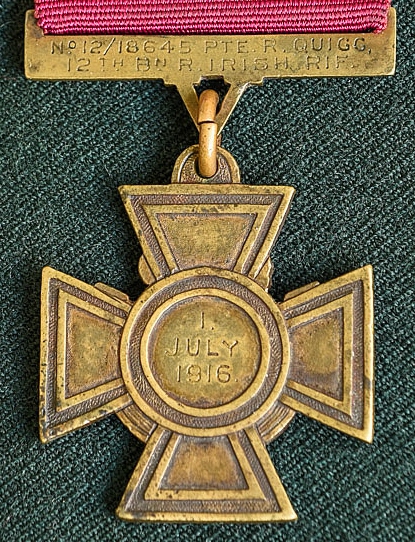The VICTORIA CROSS
The London Gazette, published on 5 February 1856, included details of the Royal Warrant signed by Queen Victoria on 29 January 1856 and stated in the preamble:
THE Queen has been pleased, by an instrument
under Her Royal Sign Manual, of which the
following is a copy, to institute and create a new
Naval and Military Decoration, to be styled and
designated "The Victoria Cross," and to make
the rules and regulations therein set forth under
which the said Decoration shall be conferred.
The final design for the Victoria Cross, with FOR VALOUR on the obverse, was approved by Queen Victoria on 3 March 1856 and incorporated a bar decorated with laurel leaves from which a link in the shape of a ‘V’ is suspended. The bronze from which all Victoria Crosses are made is supplied by the Central Ordnance Depot Donnington to the London firm of Hancocks to sand-cast and hand finish the VCs, a unique task they have been performing since manufacturing the first batch in 1856.
The rules for the award included the condition that ...'the cross shall only be awarded to those officers or men who have served Us in the presence of the enemy, and shall have performed some signal act of valour or devotion to their country'... . On 8 August 1902, King Edward VII sanctioned the posthumous award of the cross and its issue to relatives of recipients; prior to this the deceased had been gazetted only. The new regulation was retrospective, so that the surviving relatives of the men who had earned the cross in the Indian Mutiny received the medal.

The award also carries with it the right to append the letters VC after the recipient's name in addition to an annual pension or annuity. The cross is made from captured bronze cannon, and is more a cross pattée than a Maltese Cross as often described. It bears in the centre of the obverse (right ©) the royal crest of a lion passant gardant on the British crown of Saint Edward, with a ribbon inscribed FOR VALOUR in a semicircle beneath it, the ends tucked under the raised edge. The cross has a pierced semicircular lug, through which a simple link is run to attach the cross to the laureated suspender by a seriffed V. The reverse (left ©) has raised edges like the obverse, but the centre is circular. The holder's rank and regiment is engraved on the reverse of the suspender bar, and the record of the act which gained the decoration is inside the circle on the reverse of the cross. The cross is suspended by a red (crimson) ribbon.
The reverse (left ©) has raised edges like the obverse, but the centre is circular. The holder's rank and regiment is engraved on the reverse of the suspender bar, and the record of the act which gained the decoration is inside the circle on the reverse of the cross. The cross is suspended by a red (crimson) ribbon.
The Distinguished Conduct Medal (DCM) was created before the VC and remains the oldest award for gallantry, having been established by Queen Victoria’s Royal Warrant of 4 December 1854. The DCM was established earlier during the Crimean War as a decoration for gallantry in the field, but was only awarded to other ranks of the British Army. It was later described as a second level military decoration and now ranks below the Victoria Cross. The DCM was discontinued in 1993 and was replaced by the Conspicuous Gallantry Cross (CGC).
The holders of the Victoria Cross who served with our former Regiments are listed below and described as at the date of the act for which they were awarded the distinction.
Please click on a name to explore why they were awarded the Victoria Cross:
Lieutenant Hugh Cochrane 1 Apr 1858
Captain Henry Jerome 3 Apr 1858
Private James Byrne 3 Apr 1858
Private James Pearson 3 Apr 1858
Lieutenant Edgar Inkson RAMC 24 February 1900
Private Robert Morrow 12 Apr 1915
Captain Gerald Robert O'Sullivan 1/2 Jul 1915
Serjeant James Somers 1/2 Jul 1915
Captain Eric Bell 1 Jul 1916
Lieutenant Geoffrey Cather 1 Jul 1916
Private William McFadzean 1 Jul 1916
Private Robert Quigg 1 Jul 1916
Lieutenant Colonel John Sherwood Kelly CMG DSO 20 Nov 1917
Second Lieutenant James Samuel Emerson 6 Dec 1917
Private James Duffy 27 Dec 1917
Second Lieutenant Edmund De Wind 21 Mar 1918
Lance Corporal Ernest Seaman 29 Sep 18
Private Norman Harvey 25 Oct 18
(VC images subject to © control through RHQ R IRISH)






